2021 is in the books and as we move into 2022 it’s ‘trends I think are going to be big this year’ season in the world of content. While its useful to think about the trends that are likely to grow over the next 12 months, in reality, just because January 1st has been and gone the landscape of your industry hasn’t changed overnight. The trends that are going to be impactful, particularly in the first quarter or two of 2022, have already started growing.
That said, with the end of the year, we do get a nice bookend from a data perspective. Following on from my previous article on social trends around SEO, now seemed like a good time to take a step back and look at 2021. Using the social listening tool Infegy Atlas we have access to at Coast Digital, I’ve had a look at digital marketing as a top-level topic.
What we’re looking to understand from this data is:
- What were the trends across the year
- What were the big topics
- Who were the impactful influencers
We’ll then dig into the emergent trends of 2021 to understand what the winners and losers were towards the end of the year and what this might mean for the future.
Throughout, we’ll be calling out what all of this means for the upcoming year. This is one of those trends for 2022 articles in disguise –one based on the social landscape of the past 12 months, rather than personal experience.
Constructing the dataset
First and foremost, I’m looking for a broad, top-level dataset. As such, we’re pulling any publicly available social media post in 2021 that contained the phrase digital marketing or the hashtag #digitalmarketing.
Running this globally we get just over 1.5 million social media posts. As mentioned in the previous article, we can only scrape publicly available content – that means Facebook and LinkedIn tend to be counted out.
The distribution of this dataset is as follows:
- 40% Instagram
- 39% Twitter
- 14% Pinterest
- 7% Other
Geographically, the most prominent countries are the USA and India. However, when we weight this against internet population then the UK becomes the country that features in the dataset most prolifically. Canada, Australia and UAE are also significant contributors.
Regardless of geography, 89% of the scraped posts are in English – though this is likely skewed by the terms we’re using to gather the data.
As I dig further into this dataset, I’ll refine it or take segments in order to draw out useful findings. Where I’ve done this, and the rationale behind those changes, will be highlighted on the way through.
Investigating spikes in social posts around digital marketing globally
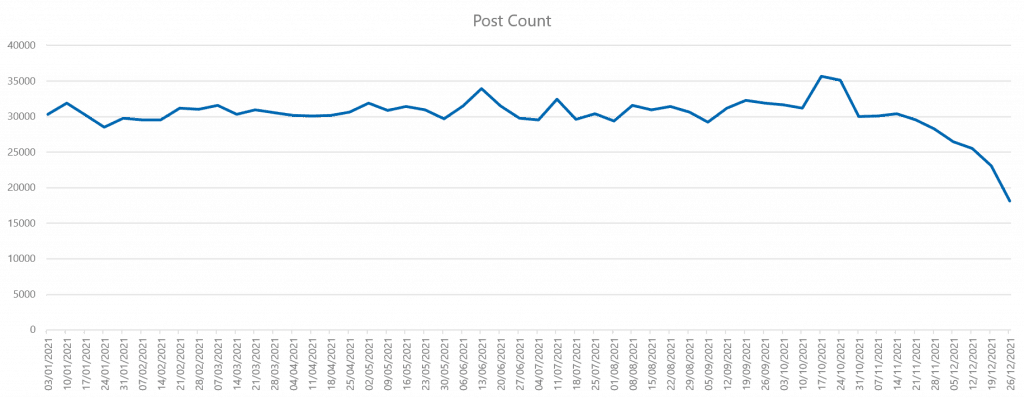
There are two interesting spikes to look at here – the first is in W/C 13/06 and the second spans W/C 17/01 to W/C 24/10.
Digging into the spike that starts on 13/06, we can see this is driven by a variety of posts across social media networks.
The biggest single post in terms of reach is the following piece of content from TechCrunch.
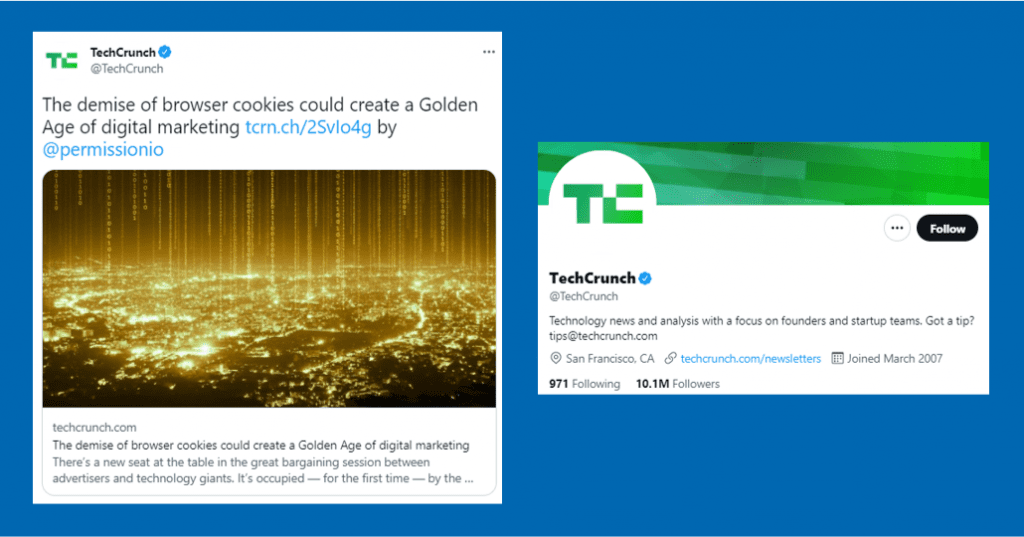
The cookieless future is an interesting topic, and one I expect we’ll be seeing more of throughout this study. Combine this with TechCrunch’s 10 million Twitter followers and you get a piece of content that carries weight in the social ecosystem.
Additionally, we see multiple posts on TikTok that have added to the spike. These include a post from @simplydigital who has 1.8 million followers and a post from @jose_azumbuja that has been shared 11.5 thousand times.

Both of these examples revolve around providing recommendations for ways to create digital assets or find tools that can be accessed for free. This kind of solution focused content clearly appeals to the entrepreneurial, ‘get stuff done’ attitude of the digital marketing industry.
Looking at the spike that starts on 17/10, we can that, in contrast, see this is driven by a news story in India.

While interesting, this isn’t particularly relevant. This demonstrates another challenge of broad, global datasets – big events like this, especially in highly populated countries, will dominate the conversation and create spikes that don’t give us anything useful from a digital marketing perspective.
Takeaways from a first look
- The post cookie internet is something digital marketers are going to have to be hyper aware of – this is something that’s been coming for a while and with big outlets covering it the question of what this looks like and what it means for the industry is only going to continue growing.
- Digital marketers want to get things done. Content that offers solutions and ways to achieve our goals makes us want to engage. We value the content creators that offer us answers to our problems in a quick and coherent fashion – though you could say that about the majority of consumer segments, especially in B2B spaces.
- Globally the volume of interest in digital marketing is relatively flat across the year. Where the trendline moves this is driven by impactful posts and engagements within the ecosystem, rather than seasonal factors.
Cutting up the dataset
One thing that seems immediately clear is that the dataset is a little too much of what I asked for. It’s a top-level global overview. While we can get some initial findings, lots of the more insightful and interesting data-points are lost due to the sheer ubiquity of social posts around this subject.
Seeing that the UK is the most engaged country as a percentage of its internet population, and being a UK based digital marketer myself, it makes sense to drill down into the UK as a segment to see if I can tease out some more specific findings.
Initial overview of the UK social landscape for digital marketing
Looking at the volume trend for the UK, we see more of what I would expect based on my experience of the digital marketing industry.
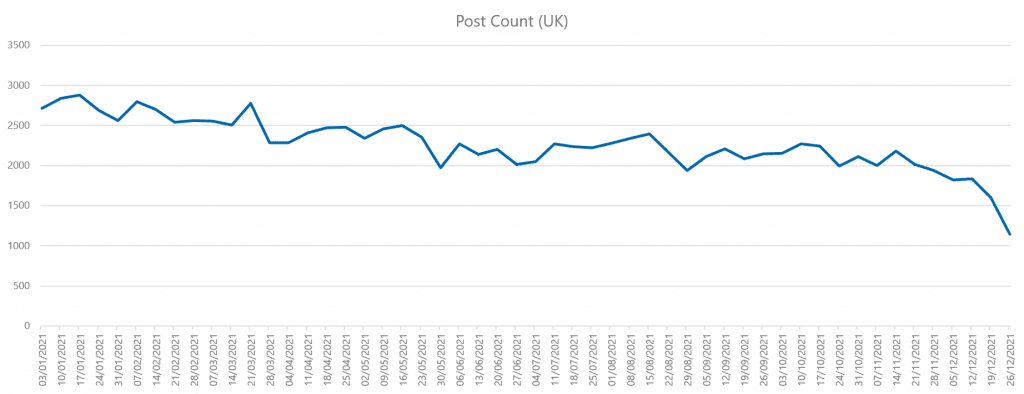
Q1 is the noisiest time for digital marketing on social media in the UK – so now is the time to produce and go looking for content in our industry. As we’d expect, the festive period sees things quieten down.
In terms of demographics, the audience in the UK trends more male and older than it does when we look at the global view.
- 67% of posters with identified genders were male, compared to only 51% in the global segment
- While there is a spread of age groups represented, the most common was 45-54, compared to 35-44 in the global view
Big digital marketing topics in 2021
Now that we have a more refined dataset, we can start to dig into some of the detail we were interested in from the outset – most notably, what were the things people were engaging with and talking about in the world of digital marketing last year.
Looking at the hashtags being used, we can see some clear winners. The most common, alongside our qualifying phrases of digital marketing and #digitalmarketing is #marketing – for the sake of this analysis we can accept that as a given and move down the list.
In order of frequency of appearance, we have the following:
- #seo
- #socialmedia
- #contentmarketing
- #socialmediamarketing
- #ppc
- #emailmarketing
Firstly, it’s interesting to see that SEO is the most common – adding credence to the finding from the social landscape study into SEO that suggested that the only people driving the claim that SEO is dead are those trying to defend it from that same claim.
One thing that is notable is that there isn’t much variety around SEO – people are hashtagging it, but they aren’t talking about the nuances around it. The opposite is true for social media marketing. Even within our top hashtags, there are two variations of social media appearing. Combining these alone gives us a sample size that is larger than the #seo. However, that’s not necessarily accurate as someone could include both of those hashtags in a single post.
Regardless, it’s interesting to note the variety of ways people are tagging social media marketing. Looking at hashtags associated with our dataset, all of the following come through:
- #socialmedia
- #socialmediamarketing
- #socialmediastrategy
- #socialmediatips
- #socialmediamanagement
- #socialselling
One explanation for this that can’t be directly proved is that this is a result of being on the channel when you’re talking about the channel – people engaged with social and creating content on social are more likely to be conscious of the different ways in which they can talk about that channel.
Digital channel trends across 2021
Taking the popular digital channels identified in the hashtags above, we can then start to get a view of how the interest in those channels has changed and developed across the year.
What becomes apparent is that there are several clusters in terms of trends across the year. Firstly, there’s SEO and social which both start strong in Q1, settle into a slightly lower baseline and peak significantly in the middle of the year. Secondly, there’s content marketing and PPC, which show peaks and growth in Q4.
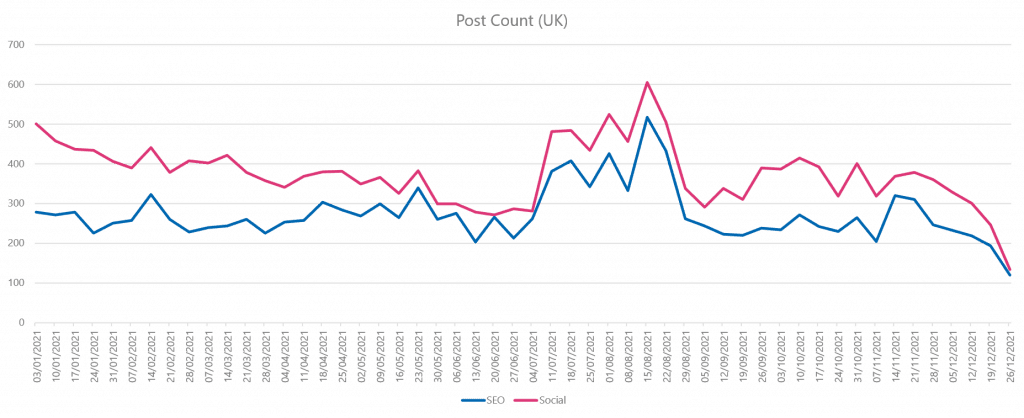
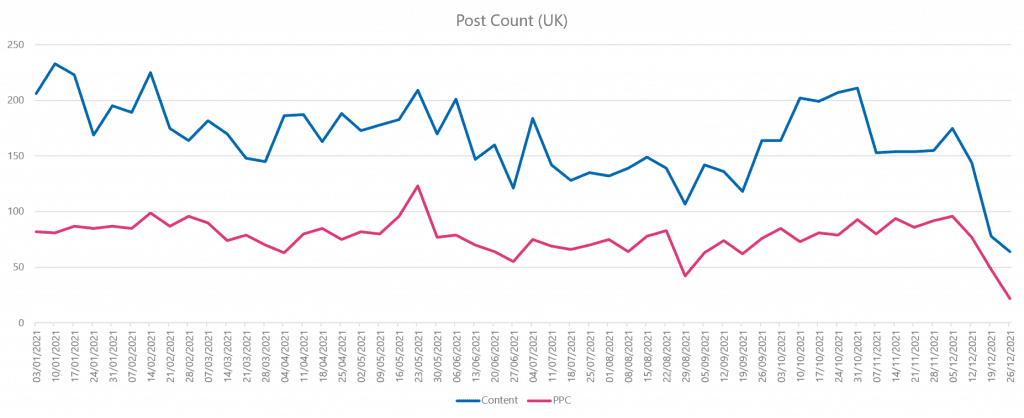
Investigating the Q3 SEO and social spike
Starting with social and SEO, both of these mid spikes start W/C 11/7 and then begin to drop back off in and around W/C 22/8. Digging into this, there isn’t a particular event, development or piece of industry news that is driving this uptick. Instead, this appears to have been driven by an influx of quality content.
This includes an industry trend report from Advertising Week and various pieces of content shared or promoted by influencers with significant audiences, including Cyril Coste, Vladimer Botsvadze, and Tony Restell.
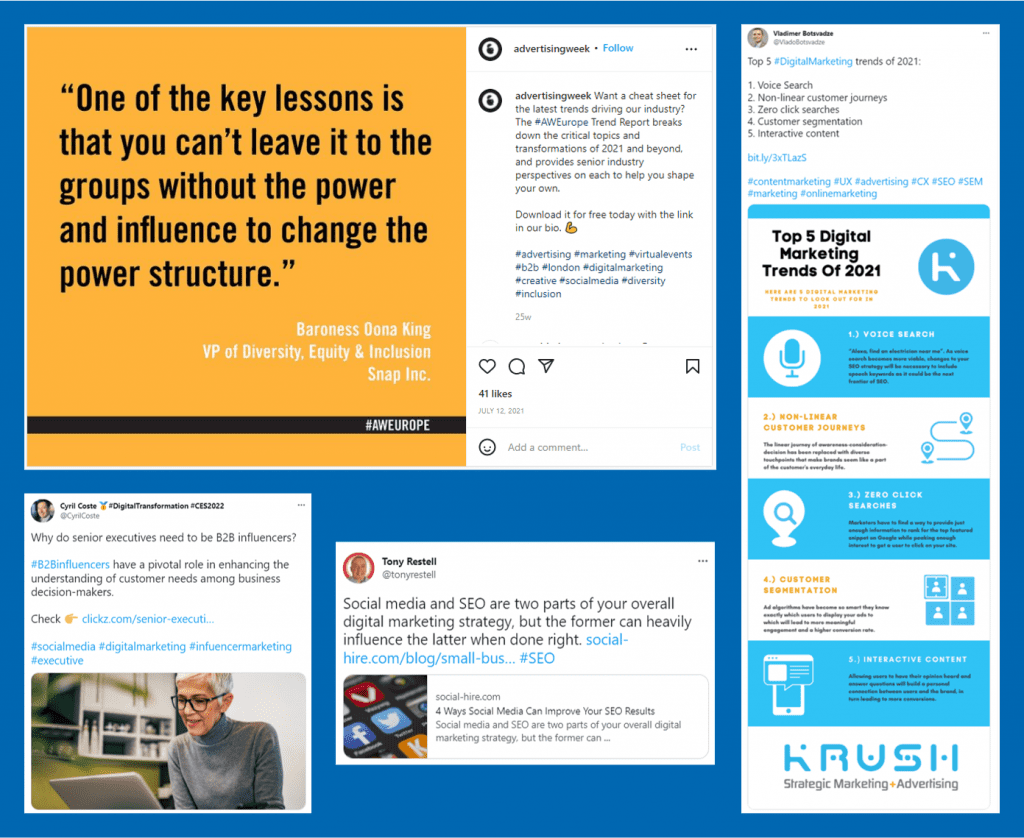
This is just an example, but it gives you an idea of the kind of content that was in the ecosystem at this time and the kinds of people that were sharing it out to their audiences. The next big question is why? Why did all of this content land at the same time and cause both social and SEO to spike. It’s a difficult question to answer after the fact, but we can theorise.
Firstly, success breeds success – quality content was hitting social networks and getting engagement, creating noise around these channels. That in turn incentivises others to get involved while the audience is engaged.
Secondly, the spike lands nicely in the middle of Q3. Q4 is going to be dominated by the festive season and all the noise that surrounds that. Furthermore, as we can see from the trend graph, overall interest in digital marketing drops off into the end of the year – though content marketing and PPC buck that trend, which we’ll dig into shortly. It’s your last chance for your best work to get a fair hearing before being drowned out by an infinite vortex of Mariah Carey and Whamaggedon.
Finally, while industry events aren’t part of the noise that forms this spike it seems unlikely to be a coincidence that BrightonSEO held an event starting 08/09, alongside the Social Media Marketing Festival in London starting 07/09. Events like this focus the industry’s attention on those channels and in turn incentivise thought leaders and influencers to drop quality content in the run-up.
A strong end to 2021 for content marketing and PPC
Both PPC and content marketing show growth into the end of the year, though these peaks are not aligned and as such we’ll investigate them separately.
PPC growing all the way into December
After a peak in May, PPC dips out to a low point in August (graph repeated below for reference) – lining up with when we see a peak in SEO and social, we can hypothesise that paid marketing suffers from the attention being given to those other channels. What we then see is a gradual growth to a high point in W/C 05/12 before a final drop away as the festive season really takes over.

It’s worth noting that PPC is a smaller topic in general, even on this peak week we’re looking at half the number of posts we can see around content marketing.
So, what are those posts? What we seem to be seeing is a peak driven by a flurry of content from service providers in the PPC space, both those offering PPC management and those offering tools to help paid advertisers.
Some of these take the form of content that entices you in, such as the examples from Adthena and 1827marketing. Others are a more direct sales pitch, which in my experience is less effective in the arena of organic social.
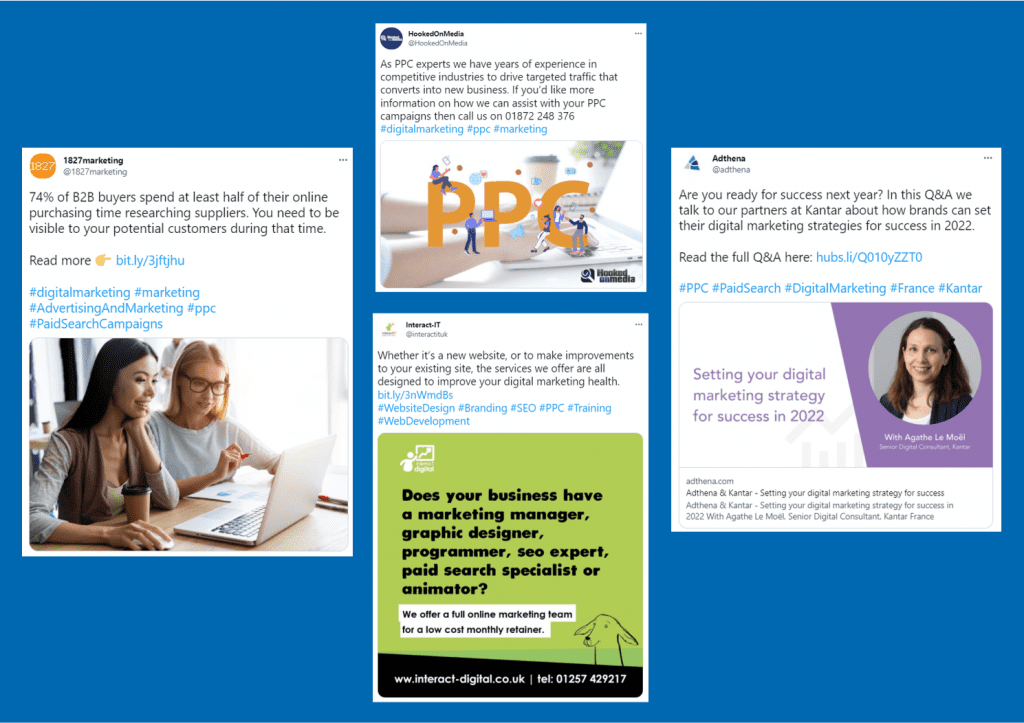
The strange world of #contentmarketing
As someone from a content marketing background I went into this part of the analysis with an expectation of what I was going to find.
The most impactful and highest reach post that landed during this spike and contributed to the engagement we’re seeing around content marketing aligned with my expectation. This post came from @designspective (443k followers for those that don’t want to click the link), sharing a piece of content originally from @benjaminmbento (104 followers).
First and foremost, this highlights the reach you can get from a good share, multiplying the visibility of the original post by a factor of 4,000. On top of that, it goes to show why it’s worth creating good content.
The post shares free tools that are valuable to content marketers and content creators. It’s well designed, concise, provides clear guidance on how the tools can help… I could go on, but instead I’d just encourage you to give it a look. You can find the original post here – a few example slides are provided below.
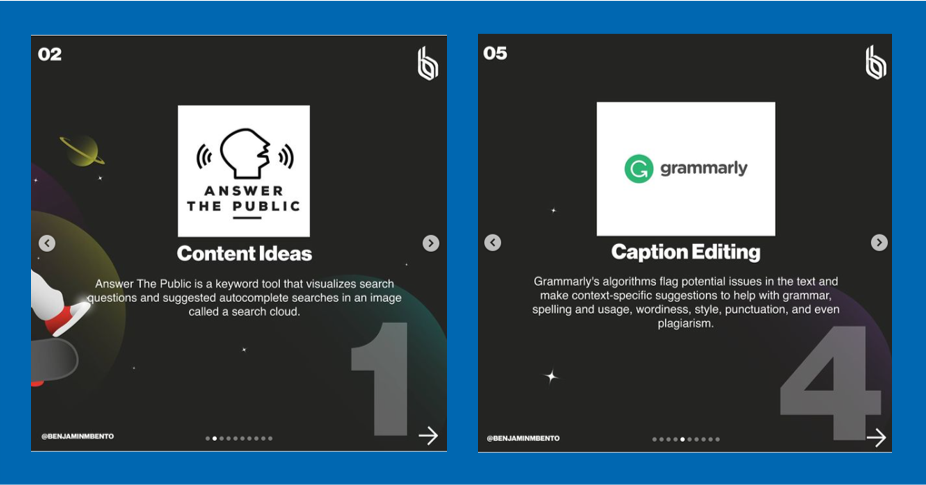
So far so good – happy to see good content making waves in the world of #contentmarketing.
As we look into the other high reach and high engagement posts, the relevance of what we can see quickly declines.
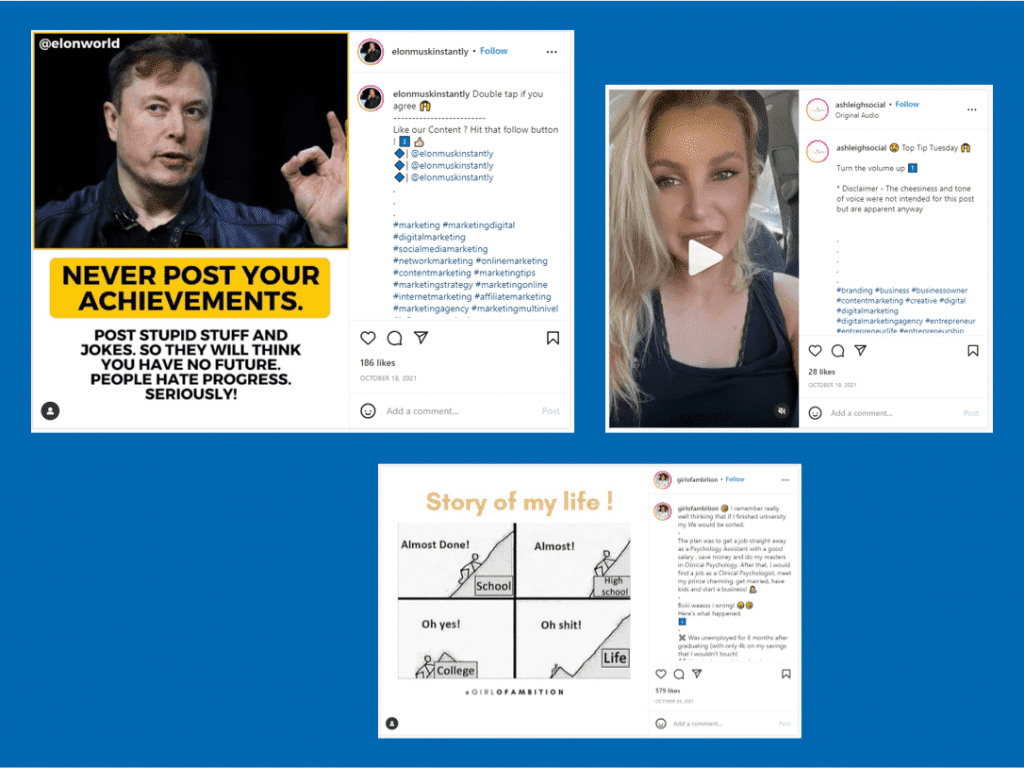
From @elonmuskinstantly to advice on how to be a #girlboss, the more we dive into posts that feature #contentmarketing, the more it becomes apparent this is a hashtag that is rarely being applied to anything about content.
This adds to the appeal of the previous post identified – if you’re a content marketer looking through social media, the post from @benjaminmbento is definitely going to stand out.
Takeaways from the UK segment
- Q1 is the noisiest time for digital marketing related content at a top level – as we would expect, this tails off into the end of the year.
- In terms of pure volume, social media marketing is the most talked about digital channel on social media. It is also the channel that is discussed with the most nuance in terms of calling out its constituent parts. This is likely a reflection of the fact these posters are talking about social media marketing on social media, and are therefore more in the know when it comes to highlighting the specifics.
- When we look at specific channels, SEO and social both spike in August of 2021. Quality content is in abundance around both channels. This may in part be due to the run-up to industry events such as BrightonSEO.
- Quality of content around SEO and social during this peak is high, with influencers and thought leaders sharing infographics and articles.
- PPC shows slow growth into the end of the year, but the quality of content being shared is mixed – there may be an opportunity here to produce higher quality social content around paid search in 2022.
- There’s an appetite for quality content around content marketing, as shown by the example post. At the same time, this subject is crowded with low relevance posts so there may be challenges if you are trying to cut through.
The biggest voices engaged with #digitalmarketing
We’ve looked at the content – now it’s time to go the other way and look at who engaged with digital marketing on social in the UK in 2021. This then allows us to work back up to the kinds of content being posted and shared by these high reach/impact influencers.
We identify influencers by looking at not only the number of followers but also how often they engaged with the topic in question over the time period reviewed.
Going down a list of influencers can turn into a ‘how long is a piece of string’ exercise, so for the sake of brevity we’re going to look at the 3 most interesting examples on the list.
Dr. Dípò Awójídé – 913k followers
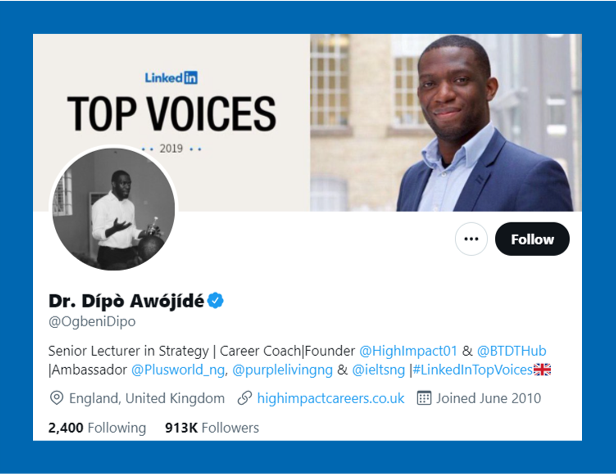
@OgbeniDipo is an interesting example first and foremost because of the size of his audience, approaching a million at the time of writing. The second interesting component is what he shares when he engages on digital marketing.
His primary way of engaging is to share content posted on @BTDTBizHub. In his Twitter bio he calls out that he’s a founder of BTDT Hub. By sharing posts from this account he is amplifying its reach, multiplying it by a factor of 120.
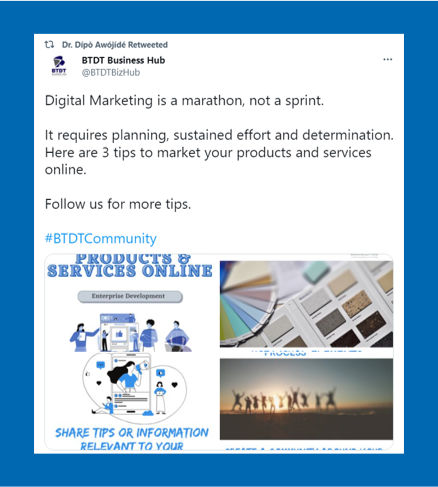
Looking at his first party posts, we see content doing well when he talks about skills – likely because this aligns with the Career Coach part of his bio. The following post has been flagged up in the dataset, not only going out to his 913k followers but also then being re-tweeted a further 550 times.
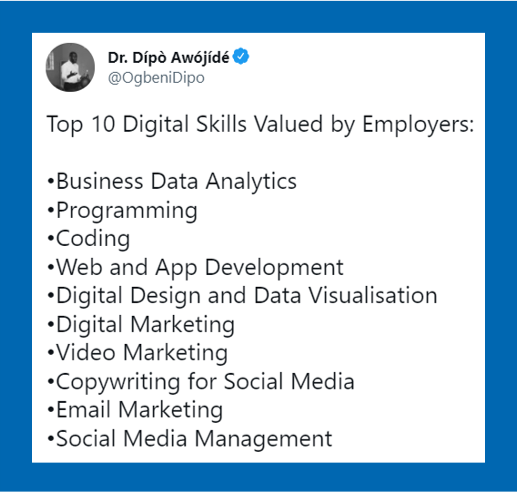
Martin Butters – 470k followers
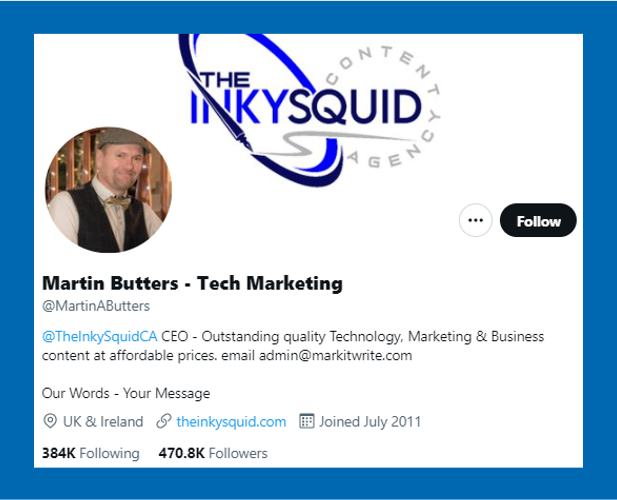
This account is a good example of why we don’t just look at follower counts when it comes to assessing influencers we want to look at around a particular topic. @martinabutters posts about digital marketing three times as often as the previous example. He’s also the CEO of a content agency, so is more directly involved with the digital marketing industry.
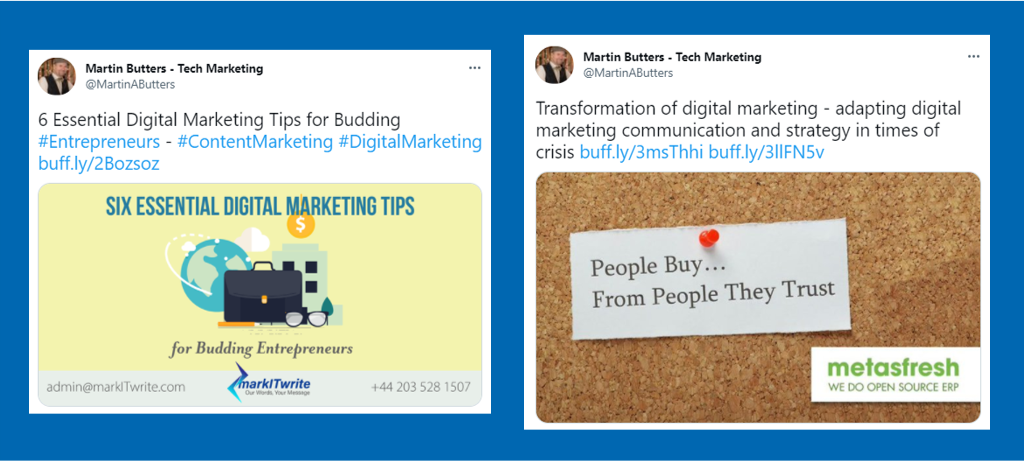
The content on Martin’s feed is relevant to our interests but not massively inspiring – if we compare it to the example we called out previously around content marketing from @benjaminmbento there’s nothing that stands out in the same way.
We can also see that interactions with this content are low, very few of the posts on this feed are being liked, commented on, or re-tweeted – what we have here is a decent sized audience from a relevant influencer, but an audience that is only softly engaged with the content that’s being produced.
Marketing Week – 237k followers
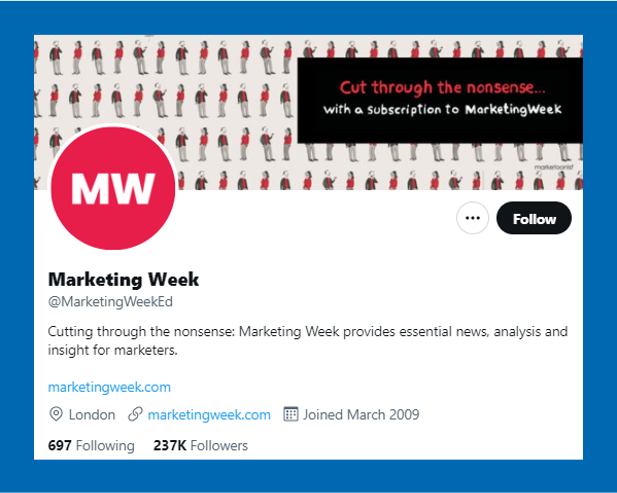
@marketingweeked post about digital marketing less frequently than @martinabutters and have a smaller follower base, but what we see is a much higher rate of engagement with the content they put out.
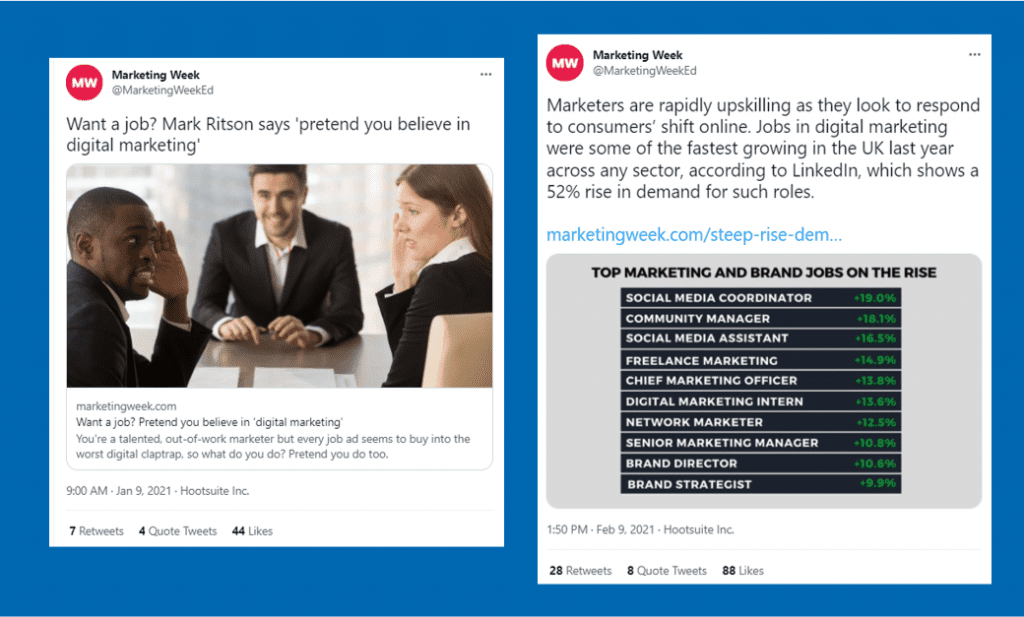
Marketing Week’s content is provocative, uses refined copy to pull the user in, and features stats that people are likely to want to reference, or well-designed imagery that make the content more engaging and appealing.
While this hasn’t resulted in a follower count to match the two previous examples, it has resulted in far higher levels of engagement from that audience. As a result, the relative value of those followers to their brand is likely far higher.
Takeaways from 2021 digital marketing voices
- The power of influencers and thought leaders to amplify the reach of content is clear, as we’ve seen multiple times you can see the potential visibility of a piece of content multiplied by factors of hundreds or more.
- The quality of content remains key – it’s all well and good having a big follower base, but that doesn’t guarantee engagement. You can have millions of followers, but if no one is consuming your content then you aren’t getting much back for your hard work.
The power of personality
This could’ve been the third bullet for takeaways, but it feels important enough to split out into its own point.
One thing we can see from this influencer review is that people – like @OgbeniDipo and @martinabutters – have the ability to draw huge follower counts even when the content and engagement levels don’t match what we see from someone like @marketingweeked and other reputable content producers.
Part of this comes down to the work that these people have put in and the exposure they have been able to achieve – social followings don’t exist in a vacuum, it’s not just down the quality of the content you’re producing or sharing.
However, it also shines a light on an important concept. Social media and our willingness to engage with it often comes down to a human connection. That’s not to say we won’t follow brands, but there’s a reason why influencer marketing is a powerful and growing field – nine times out of ten a recognisable face is going to draw you in more than any faceless brand.
We can see this in the above example, but it’s something I’ve come across in my day to day work.
I was investigating the social landscape and impactful content for a FinTech client and came across 11:FS and their podcast – the Fintech Insider podcast.
What I noticed as I dug into this is that while @11FS itself has 19.5k followers, the CEO @davidbrear and co-founder @sytaylor both have over 40k followers each.
The takeaway from all of this is that if you seriously want to make an impact on social media, if you want to be a thought leader and want your brands message to be heard and engaged with, then you need to consider putting that message in the hands of people, not the brand itself.
Can you empower senior people in the brand to be those thought leaders, to promote those messages, to build an audience that will then amplify the reach of your brand’s content? If you can do that, then you give yourself a better chance of succeeding in the organic social sphere.
Emergent trends in digital marketing
As mentioned at the top of the article, the trends that dominate H1 of 2022 won’t come out of nowhere. The seeds of those trends have already been planted. To get a data-driven view of this, we can start by looking at which topics have seen significant growth in 2021. These emergent trends in 2021 are ones to watch for 2022.
The most shared post in 2021
A good place to start is with the single most shared post around digital marketing last year. For this, we’re looking globally across all posts that mention digital marketing or #digitalmarketing. The single most shared post was on TikTok from @samdespo, which has been shared 67k times. You can see the post in question here.
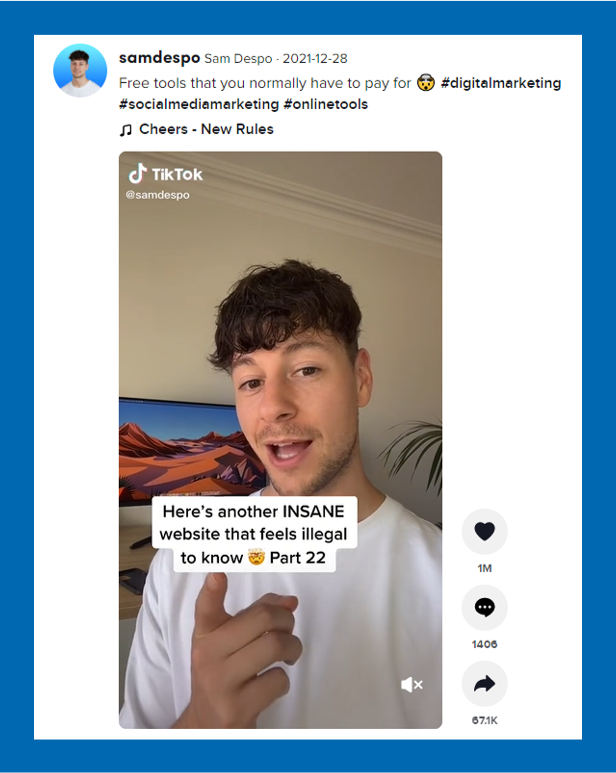
This post is an interesting case for two reasons. Firstly, because it reinforces what we saw earlier around tools and solutions. People interested in digital marketing are keen to get their hands on new tools or websites or services that can help them do their jobs better – if those tools are free, then even better.
The second reason this post is interesting is because it is in and of itself representative of a trend that digital marketers are going to need to be hyper-aware of in 2022. That being TikTok itself.
Back in September 2021 it was reported that TikTok overtook YouTube in terms of average watch time, both in the UK and in the US.
What’s particularly interesting here is that even in the world of B2B, where you have content being provided to digital marketers in the form of tips, advice and tool recommendations, TiKTok is leading the way in terms of the most shared and engaged with content.
Growing interest in social media strategy
When we look at growth topics around digital marketing and #digitalmarketing in the UK, the trend that stands out is around social media strategy. #socialmediastrategy is the most drastically growing trend we can see, with a notable spike in Q4.
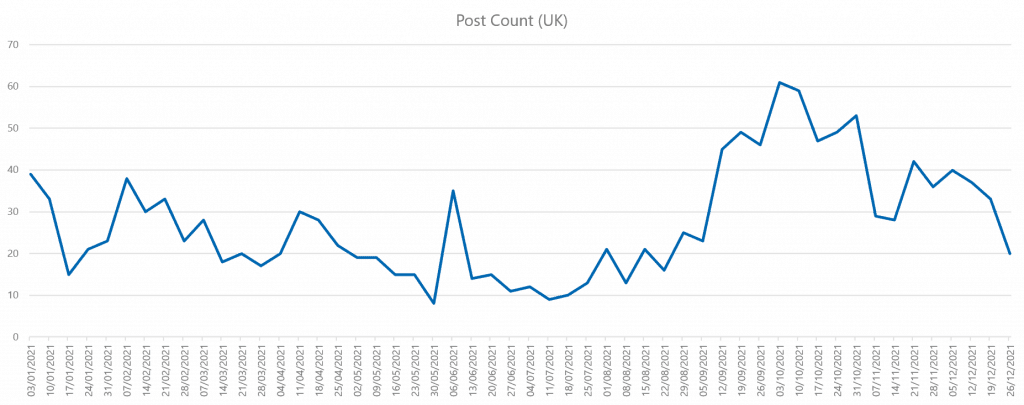
It’s worth noting that, as we saw previously, the festive period is a lull for digital marketing topics as a whole, but still #socialmediastrategy makes it through Christmas at a higher volume than it was showing at the midpoint of the year.
Looking at posts with strong reach and high levels of engagement, two examples of content that factor into this trend are the following:
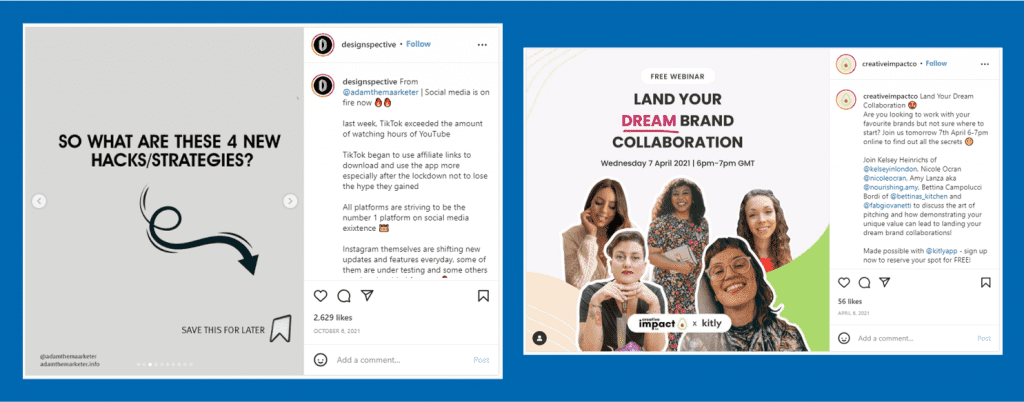
These touch on two components of the evolving social media landscape – TikTok and influencer marketing. As we’ve seen previously, these popular posts trend towards advice and tips.
As the options available on social media diversify, the importance of strategy continues to grow. Long gone are the days of throwing up a few organic posts on your brand’s Facebook page and calling it a day, now you need to craft the right approach from a huge range of opportunities.
Utilising the right mix of social channels, combining paid advertising with influencers, understanding what kind of ads and campaigns you should be running, having a good grasp of who your audience are and what kind of messages they need to hear… the list goes on, and shows why social media strategy will likely continue to become a bigger and bigger topic over the next 12 months.
Takeaways from emergent trends in 2021
- Tips, advice, tool recommendations, solutions – these are all big winners in the social landscape of digital marketing. It’s a good lesson to learn for B2B marketing in general, if you can provide your audience with good answers to their problems they’re likely to reward you with engagement.
- TikTok isn’t just for discovering sea shanties. While its increasingly understood that TikTok is a driving a big shift in social media consumption, it’s perhaps not as well understood that this shift is impacting B2B industries like digital marketing.
- Social media strategy is one of the biggest growing digital marketing trends for 2021, with a notable spike late in 2021 that suggests it will continue to loom large in the early parts of 2022. With what we can see from the growth in TikTok and the growing options around social media marketing, it’s no wonder social strategy is being seen as increasingly important.
Summary and what to take forward into 2022
Social listening is an extremely powerful tool – the scope of what’s possible once you have a view of the social landscape is not to be underestimated. What might once have simply been a way to track your brand mentions now gives us access to all of the insights we’ve seen above.
It’s a huge amount of data, and as a result we end up with an array of takeaways. So if we were to boil it all down, what do we end up with? I think we can come away with 5 key points from 2021 that we can take forward into 2022.
- TikTok is a big deal, whatever industry you are in – you might think it doesn’t apply if you’re in the B2B space, but as we’ve seen there’s content that’s driving huge engagement in a B2B space like digital marketing.
- The human touch still matters on social – when we look at the most engaged with content and the most powerful influencers, what we see are people rather than brands. Empowering personalities within your brand to be your thought leaders on social media is something to consider.
- Social media strategy is growing in importance – we can see this from one perspective in the data itself, with the diverse and changing nature of the kinds of content and channels we’re looking at, and then we can see from the other perspective with #socialmediastrategy being the biggest growing trend within digital marketing.
- #contentmarketing presents a gap in the social market – there’s a surprising lack of quality content about content marketing, and when quality content appears around the subject it gets snapped up. The space is flooded with semi-relevant posts, with #contentmarketing being a buzzword for MLM influencers, but if you can cut through there’s an audience keen to consume quality assets.
- Meeting user needs is as important on social as anywhere – as we see time and time again from a UX perspective, when we meet our users’ needs we get good outcomes. That holds true on social media, where we see those offering tips, tools, advice, and solutions in the digital marketing space being the profiles that flourish and prosper.
Conclusion
Digital marketing is just one industry – the true power of social listening is that this data exists for any industry, any brand, any topic.
As we’ve seen in the above example, having more data is good but sometimes cutting down to a smaller data set allows for better insights. That means it’s not just limited to big topics or big brands – anything where there’s an audience engaging on social, there’s an opportunity to draw out insights that can inform not only your approach on social media, but your wider digital marketing strategy as well.
If you’d like to know more about the scope of what’s possible with social listening, you can read our free social listening guide here.
